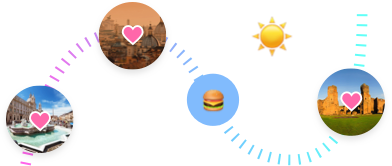



The Giuseppe Verdi opera house is the main theater in Trieste. It was built on a private initiative between 1798 and 1801. The original project was by Giannantonio Selva, also designer of the Fenice in Venice, to whom we owe the interiors. Matteo Pertsch took over the job later and was primarily concerned with the facades. The influence of Giuseppe Piermarini, Pertsch's teacher and designer of La Scala in Milan is evident in the main facade. The definitive arrangement of the room is due to the restorations of 1882-1884 which took place under the direction of Eugenio Geiringer. On that occasion the current decorations of the hall were also carried out (by Josef Horwath), while the building was extended in the rear part with the creation of the current posterior façade which takes up the design of the main one. It was inaugurated with the name Teatro Nuovo and was then called Teatro Grande (1820), then Teatro Comunale (1861) and finally Teatro Comunale Giuseppe Verdi (1901). The first performance took place on April 21, 1801 with Geneva of Scotland by Simon Mayr with Teresa Bertinotti, Luigi Marchesi, Giacomo David. In 1820 it was renamed into the Teatro Grande and the world premiere of Giovanni Pacini's The Priestess of Irminsul took place, in 1828 the première of Il Divorce Persiano by Pietro Generali (composer) and I crociati a Ptolemais that is Malek-Adel by Pacini, in 1832 of Ricciarda of Edinburgh by Cesare Pugni, in 1838 by The Prison of Edinburgh by Federico Ricci, in 1839 by Enrico II by Otto Nicolai with Carolina Ungher, Napoleone Moriani and Domenico Cosselli, in 1844 Painter and Duke by Michael William Balfe and in 1845 Isabella de' Medici by Ricci. In the 1843-1844 opera season, Giuseppe Verdi's Nabucco achieved an extraordinary success with the public as witnessed by over twenty performances. In 1848 it hosted the first absolute performance of the work, by the same author, Il corsaro with Gaetano Fraschini, Achille De Bassini and Marianna Barbieri-Nini and in 1850 that of Stiffelio with Marietta Gazzaniga and Filippo Colini. In 1861 the municipality of Trieste became the owner of the building, which changed its name to Teatro Comunale. In 1852 the world premiere of Maria di Brabante by Achille Graffigna took place, in 1865 Romeo and Juliet by Filippo Marchetti with Angelina Ortolani, Mario Tiberini and Leone Giraldoni and Marion de Lorme by Carlo Pedrotti and in 1872 Gustavo Wasa by Apolloni with Giuseppe Capponi and Ormondo Maini. In 1883 the Wagnerian tetralogy directed by maestro Anton Seidl was performed in its entirety. In 1895 the world premiere of Nozze Istriane di Smareglia took place with Gemma Bellincioni and Roberto Stagno. The repertoire of the young Italian school initially struggled to establish itself but, subsequently, the works of some realist authors (Pietro Mascagni and Ruggero Leoncavallo in particular) and those of Giacomo Puccini entered the theater repertoire permanently. On 27 January 1901 it was named after Giuseppe Verdi following an extraordinary resolution by the municipal council, convened on the night of the great composer's death. The theater has been subject to various maintenance and restoration works, the most important in 1881, thanks to which the capacity of the theater was increased, and in 1889. In 1906 Medea (Tommasini) premiered, in 1921 Fanfulla by Attilio Parelli, in 1923 La monacella della fontana by Giuseppe Mulè, in 1925 Scampolo by Ezio Camussi, in 1928 Flemish painters (opera) by Smareglia, in 1940 Il reviewer by Amilcare Zanella, in 1967 The damned jacket by Giulio Viozzi and in 1970 Hope by Franco Mannino. The 1951 Boris Godunov (opera) directed by Antonino Votto with Nicola Rossi-Lemeni and Fernando Corena and the 1953 Norma (opera) directed by Votto with Maria Callas, Franco Corelli, Boris Christoff and Elena Nicolai still remain in the memory. The last restoration took place between 1991 and 1997. He is known throughout Europe for the International Operetta Festival (from 1950 to 2011).